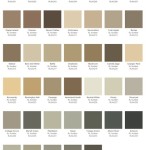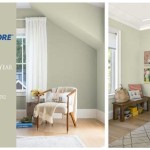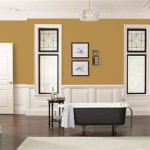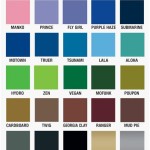```html
The Power Of White Paint Colors
White paint, often perceived as a simple and neutral choice, possesses a remarkable power to transform spaces and influence the overall aesthetic of a room. Its versatility stems from its ability to act as a blank canvas, reflecting light and allowing other design elements to take center stage. Understanding the nuances of white paint and its application can significantly enhance the visual appeal and atmosphere of any interior.
The perception of white as a single entity is a misconception. In reality, the spectrum of white paint colors is vast, ranging from cool-toned whites with hints of blue or gray to warm-toned whites with undertones of yellow or beige. This subtle variation allows for tailored selection based on the specific characteristics of a room, including its natural light exposure, size, and existing décor. Choosing the right white can be the deciding factor in achieving the desired look, whether it's a crisp, modern feel or a cozy, inviting ambiance.
The impact of white paint extends beyond mere aesthetics. It can influence the perceived size of a room, enhance the reflectivity of light, and create a sense of calm and serenity. Furthermore, the choice of white can significantly affect the way other colors are perceived within the space, either accentuating their vibrancy or providing a subtle backdrop.
Enhancing Perceived Space and Light
One of the most significant benefits of using white paint is its ability to expand the perceived size of a room. Light colors, including white, reflect more light than they absorb, making a space feel brighter and more open. This is particularly useful in smaller rooms or rooms with limited natural light. By reflecting light, white paint eliminates shadows and creates a sense of airiness, making the room feel less cramped and more inviting.
Conversely, darker colors tend to absorb light, making a room feel smaller and more enclosed. Therefore, in rooms where maximizing space is a priority, white paint is an ideal choice. The reflective properties of white can also help to highlight architectural details and create a sense of depth, further contributing to the illusion of a larger space.
The sheen of the paint also plays a role in light reflection. Higher sheen paints, such as gloss or semi-gloss, reflect more light than matte finishes. While high-sheen paints can be effective in brightening a room, they also tend to highlight imperfections on the walls. Therefore, the choice of sheen should be carefully considered based on the condition of the walls and the desired aesthetic.
In rooms with ample natural light, white paint can further enhance the brightness and create a vibrant atmosphere. However, it's important to consider the direction of the light. South-facing rooms typically receive warm light, so a cooler white might be a good choice to balance the warmth. Conversely, north-facing rooms receive cooler light, so a warmer white can help to create a more inviting atmosphere.
Creating a Versatile and Neutral Backdrop
White paint provides a versatile and neutral backdrop that allows other design elements to shine. It acts as a blank canvas, allowing furniture, artwork, and accessories to take center stage. This makes it an ideal choice for those who enjoy changing their décor frequently or who want to create a space that is adaptable to different styles.
The neutrality of white paint also allows for greater flexibility in color selection for furniture and accessories. Bold and vibrant colors will stand out against a white backdrop, while more muted tones will create a subtle and sophisticated look. This versatility makes white paint a practical choice for both residential and commercial spaces.
Furthermore, white paint can be used to create a cohesive look throughout a home or office. By using a consistent white color palette, it is possible to create a sense of unity and flow between different rooms. This is particularly useful in open-plan spaces, where it's important to create a sense of harmony and continuity.
The choice of white paint can also influence the perceived texture of a room. Matte finishes tend to create a softer and more muted look, while gloss finishes can add a touch of sophistication and elegance. The texture of the walls themselves can also be enhanced by using textured paint or applying different painting techniques.
Selecting the Right White for the Specific Space
The selection of the right white paint color is crucial to achieving the desired aesthetic and atmosphere. While the term "white" may seem simple, the reality is that there are countless shades of white, each with its own unique undertones and characteristics. Understanding these nuances is essential to making an informed decision.
One of the most important factors to consider is the amount of natural light in the room. As mentioned earlier, south-facing rooms receive warm light, while north-facing rooms receive cooler light. Therefore, the choice of white paint should be balanced with the natural light to achieve the desired effect. In rooms with limited natural light, a warmer white with undertones of yellow or beige can help to create a more inviting atmosphere. In rooms with ample natural light, a cooler white with undertones of blue or gray can help to create a brighter and more refreshing look.
The existing décor of the room is another important factor to consider. The white paint should complement the furniture, artwork, and accessories in the room. For example, if the room has a lot of warm-toned furniture, a warmer white might be a better choice. Conversely, if the room has a lot of cool-toned furniture, a cooler white might be a better choice.
It is recommended to test different white paint colors in the room before making a final decision. This can be done by painting small swatches of each color on the walls and observing them at different times of day and under different lighting conditions. This will help to ensure that the chosen white paint color is the right fit for the specific space.
Furthermore, it is important to consider the sheen of the paint. Matte finishes are typically used in bedrooms and living rooms, while semi-gloss or gloss finishes are typically used in kitchens and bathrooms, where they are more resistant to moisture and easier to clean. The choice of sheen should be based on the specific needs of the room and the desired aesthetic.
In conclusion, white paint colors offer a versatile and powerful tool for transforming spaces. By understanding the nuances of white paint and its application, it is possible to create a room that is both aesthetically pleasing and functionally sound. The ability of white to enhance space, provide a neutral backdrop, and adapt to various lighting conditions makes it a timeless and indispensable choice for interior design.
```The 10 Best White Paint Colors As Chosen By Designers Jenna Sue Design
The 10 Best White Paint Colors As Chosen By Designers Jenna Sue Design

Discover The Power Of White Paint Learn About

The 12 Best White Paint Colors According To Experts Young House Love

Best Sherwin Williams White Kind Home Solutions

The Power Of Paint Sherwin Williams Painting Week Deeply Southern Home

40 Best White Paint Colors 2024 Designers Favorite
The Power Of Color White Martine Claessens

The 10 Best White Paint Colors As Chosen By Designers Jenna Sue Design

The Power Of White Less Than Perfect Life Bliss
Related Posts








